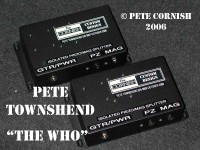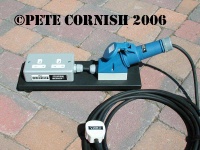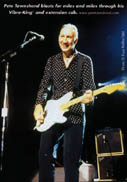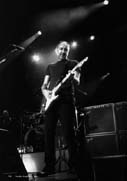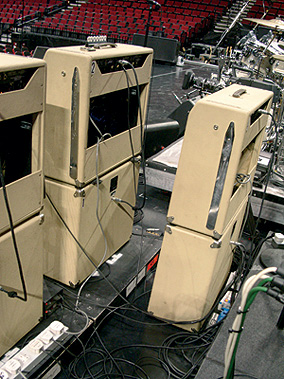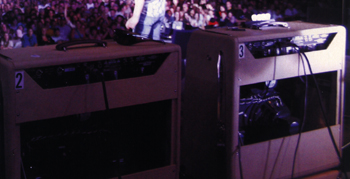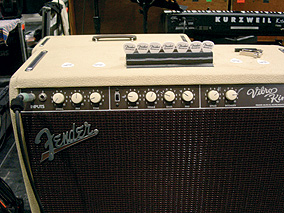Pete’s Gear: Fender Vibro-King amplifier combos and extension cabinets
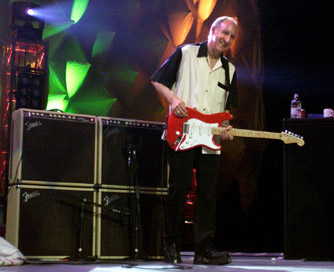
Ca. 2000, in front of dual Fender Vibro-King combos and extension cabs. Guitar is Fender Eric Clapton model Stratocaster.
In recent years, with the Who’s resurgence on the concert stage as a five piece, beginning in 2000, Pete has used Fender Vibro-King amplifiers, paired with his Fender Eric Clapton model Stratocasters.
His first use of these amplifiers was for solo performances in 1998, where he would use the Vibro-King for the electric split.
Then, following a brief use of Hiwatt DR103Ws for the Who’s first outings as a five-piece in 1999, he switched to the Fender Vibro-Kings and has used these amplifiers almost exclusively until present. (He again went back to including Hiwatt in his rig — one Hiwatt Custom 50 signature series model CP103 50w amplifier into one Mesa/Boogie 2×12 vertical speaker cabinet, set up as half-stack — for early 2006 shows, including it in between two Vibro-King stacks. In 2010, used a Lazy-J stack in between the two Vibro-King stacks; and in 2015, a Vibrolux Reverb 2×10.)
Specification:
- Fender Vibro-King amplifier:
- 60w 3×10″ combo.
- 10″ JBL speakers or 10″ Eminence blue frame Alnico speakers.
- Blond Tolex covering and oxblood grill cloth.
- Sovtek tubes.
- Fender two-button footswitch controller.
- Fender Vibro-King 212 Speaker Enclosure:
- 12″ JBL speakers.
- Birch plywood, blond Tolex covering and oxblood grill cloth.
- Closed-back cabinet.
Alan Rogan discusses Pete’s Stratocasters and Vibro-Kings.
2006 setup
Pete’s “stack” consists of one Vibro-King 3×10 combo on top of one Fender Vibro-King 212 2×12 speaker cabinet. He uses one or two stacks (depending on venue size) as the primary amplifier rig, with one or two stacks as backup, powered on and set up behind the primary amplifier(s). Then there is a third rig offstage for troubleshooting. The guitar signal is passed through a Pete Cornish Custom Design piezo/magnetic splitter (Pete Townshend s/n 0602, built August 2006). The piezo signal is sent to DI boxes, and to the PA. The magnetic pickups’ signal is sent to the Pete Cornish pedalboard, and back to another Cornish “A/B/C Box” splitter, and to the three amp setups:
- A to onstage Vibro-King(s)
- B to offstage Vibro-King(s)
- C to another Cornish splitter, which would bring in the rear (spare) Vibro-King(s). (Spares are powered on, but on stand-by so that the amp can’t be accidentally be brought in by PT.)
Beginning in 2012, Pete placed TubeTrap foam baffles, made by Acoustic Sciences Corp., in front of the amps to shield stage sound level.
Signal paths
2000–2002 basic signal path:
Guitar (magnetic) pickups —> MXR Dyna-Comp —> Boss OD-1 —> [splitter box] —> Vibro-King/cabs —> SM-57 (or Shure KSM44) —> PA
Fishman (piezo) pickup —> [splitter box] —> Demeter VTDB-2B Tube Direct Box DI —> PA
2004–2006 basic signal path:
Guitar (magnetic) pickups —> MXR Super Comp —> Boss OD-1 —> [splitter box] —> Vibro-King/cabs (and Hiwatt) —> mic —> PA
Fishman (piezo) pickup —> [splitter box] —> Demeter VTDB-2B Tube Direct Box DI —> PA
2006–present basic signal path:
Guitar (magnetic) pickups —> [splitter box] —> Cornish custom effects pedal board —> [A/B/C splitter box] —> Vibro-King/cabs (three sets, see above) —> mic —> PA
Fishman (piezo) pickup —> [splitter box] —> Demeter VTDB-2B Tube Direct Box or Fishman DI —> PA
Amp settings, ca. 2009:
- FAT:
- On
- Volume:
- 3/3.5
- Treble:
- 6/7
- Bass:
- 3.5
- Mid:
- 4
- Speed:
- 7
- Intensity:
- 7.5
See the main equipment index for full rig details.
Note: In 2010, a KSM313 ribbon mic was used to mic the Vibro-Kings. See microphones for more detail.
Selected quotes
All quotes and references are copyright their original owners and are included for reference only.
Endorsement
From Pete’s 2003 endorsement of these amplifiers in the 2003 Fender catalogue:
“They do exactly what I need … [like] the massive rigs of the ’60s I used to use. Remember that the first Marshall amps were very close emulations themselves of the Fender amps I first used — and which I asked Jim Marshall to make ‘ten times as loud!’. Today, this rig fills every hall I come across. If I play a stadium, I simply add another rig, but rarely need to turn it above ‘2’. I’ve never ever come close to using my basic setup over half volume. Forget ‘eleven’, these babes go up to fifty-seven. And they are Fender. The real thing. There are very few products Fender has made — even in bad times — which were ugly. This amplifier is so pretty I have one in my living room next to the expensive furniture. It reminds me why I wanted to play guitar in the first place. I thought I looked prettier with a guitar. I do. But with a Fender Strat and a Vibro-King I’m as cool, as irresistible as James Dean.”
— Pete Townshend, November 2002
From May 17, 2004, Gibson Guitars interview: J-200s, regrets over smashed guitars, The Who ‘Then and Now’ and more: Q&A with Pete Townshend
- What precautions do you take when you play live to protect your ears?
I use smaller amplifiers than in the old days.
Excerpt from The Soul of Tone: Celebrating 60 Years of Fender Amps interview with Alan Rogan
Pete Townshend’s longtime guitar tech Alan Rogan: “Pete gets a killer sound through Fender amps. On recent tours he’s playing through a Vibro-King with the Vibro-King extension cab, so it’s three 10s and two 12s. He’s using two of these stacks onstage, but only one of them is miked. Onstage we start off at volume 2, maybe 2½. That’s it. The second amp is on but we start with the volume turned all the way down. As the show gets ‘larger,’ if you like, Pete just adds it in. It’s not a monitor. It’s just there for Pete if he wants it. it makes the whole sound picture far bigger. It all depends on the gig.
“Along with the one Vibro-King we had tried a new Hiwatt back in 2004, a 100 watt amp with four 12s. It was great but it was just too big, too much, so we went with the pair of Vibro-Kings, and that setup just suits Pete down to the ground. He loves it so much. He records with them as well. I always take one or two ’round to the studio, and they live there for his convenience.
“Pete’s using an old Clapton Strat, meaning it has the Lace Sensors rather than the Noiseless pickups. It does have a Fishman on board with the extra knob, but otherwise it’s stock, and he goes through the one or two Vibro-Kings. All my buddies come to the show, including John Porter, the producer and a great guitar player himself. They all say they never heard a live sound — anywhere, ever — as good as Pete’s.”
From interview with Michael Kaye, guitar/amp tech on recent Who tours, from Performing Musician magazine
“Pete plays Fender Stratocasters, which have gold Lace Sensor pickups,” says Michael Kaye. “And they’ve got the Fender preamp on board, which gives a 25dB boost. They also have a Fishman Power Bridge, which gives a piezo signal [for Pete’s acoustic sounds]. The signals from the guitar go to a Pete Cornish splitter box, and the piezo then goes through to two DIs — a main and a spare. The main is a tube Demeter DI and the spare is a Fishman Platinum Pro DI. It’s not happened recently, but we have had problems in the past with valve DIs failing, and that’s why we have two of them in the signal path at all times, so if there’s a problem we can switch to the spare. The magnetic signal from the pickups goes through the Pete Cornish splitter and then out to a Pete Cornish pedalboard, which has a compressor, an overdrive and a delay in it. Then the signal goes back to the splitter box, which splits his signal to a number of amplifiers. Pete uses Fender Vibro-King amps with a 2 × 12 extension cabinet underneath, and if you look at the Who stage you’ll see four stacks up there. The front two stacks are used through the show, while the rear stacks are spares. We can switch them instantly by means of a footswitch, so everything’s there and everything’s on all the time!”
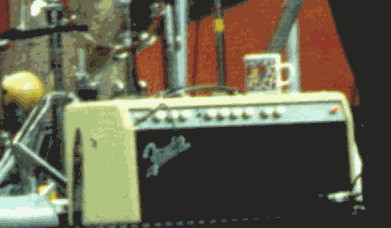
Close-up of Fender Vibro-King, ca. 1998.
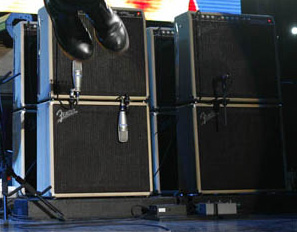
Ca. 2006, detail of Fender Vibro-King primary/backup setup (microphones: left: Shure KSM44; right: Shure SM-57). Cornish splitter boxes visible at bottom.
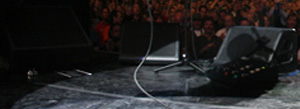
Ca. 2006, at very left of photo, two-button Fender control pedal visible in shadow under large wedge monitor. (Pete Cornish custom pedal visible at right of Pete’s mic stand.)
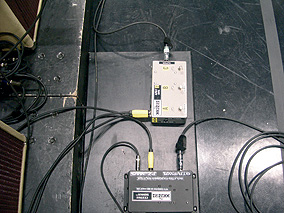
Closeup of Pete Cornish splitters: “A/B/C Box,” top, which brings in the separate amp stacks; and Piezo/Magnetic splitter, bottom, with the guitar input and piezo and magnetic signal outputs.
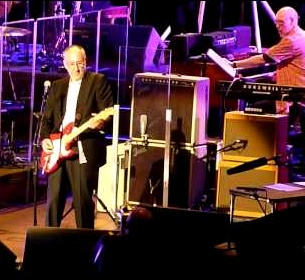
30 March 2010, at the Royal Albert Hall, with Lazy J 20 “stack” next to one Fender Vibro-King combo/extension cab stack, and another Vibro-King facing toward the drumkit. Guitar is Fender Eric Clapton model Stratocaster.
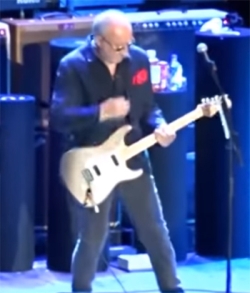
Click to view larger version. September 2016, Lazy J Model 40 visible next to Vibro-King. TubeTraps visible in front of amps.
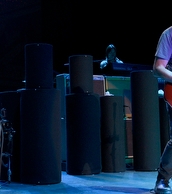
Ca. 2016, detail of TubeTraps in front of Fender Vibro-King stack.
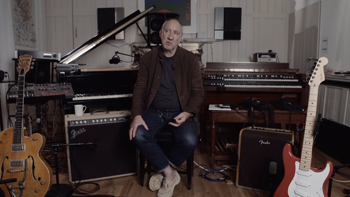
Click to view larger version. Ca. 2016, Pete at his studio promoting the Fender Custom Shop Limited Edition Pete Townshend Stratocaster®, with, from left, Gretch Chet Atkins, Fender Vibro-King, Fender Acoustic SFX and Fender Eric Clapton Stratocaster.
Resources and Information
Manufacturer:
- Fender: fender.com
Information:
- Fender Amp Field Guide: ampwares.com/ffg/vibro_king.html
